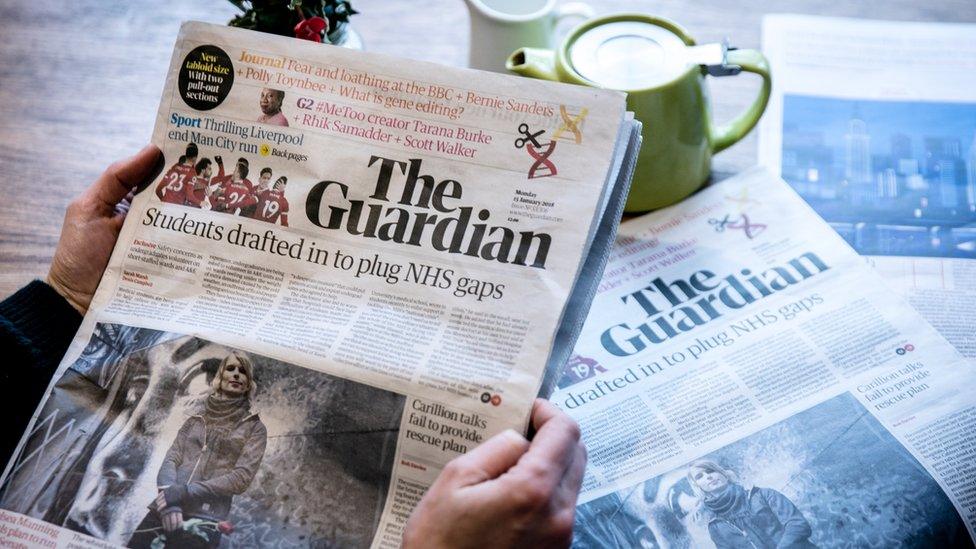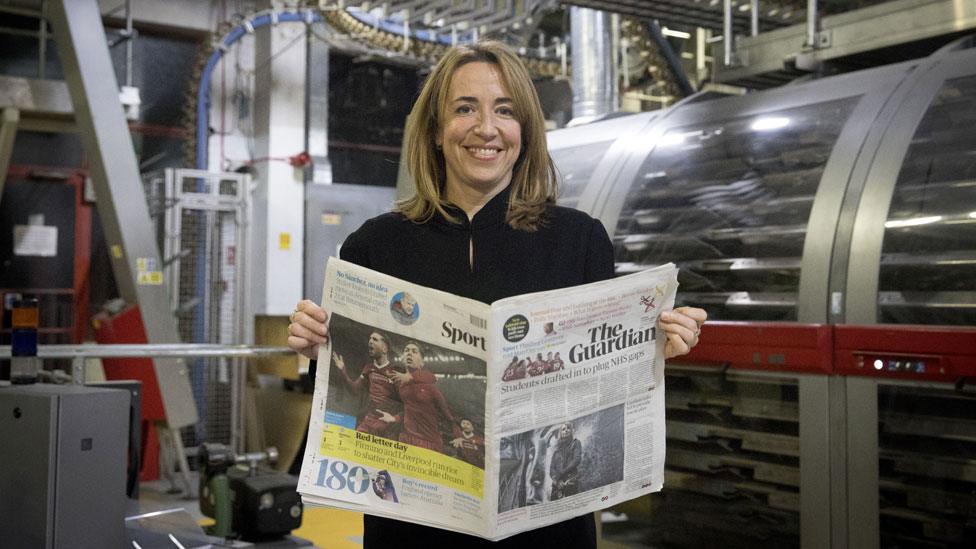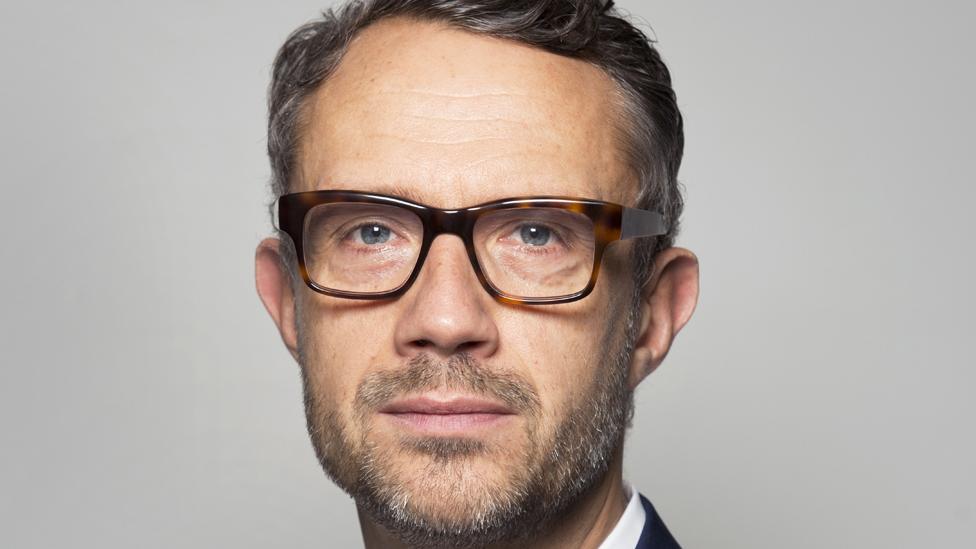Guardian records first operating profit since 1998
- Published
- comments

The Guardian's results are a vindication of the strategy pursued by Chief Executive David Pemsel and Editor-in-Chief Katharine Viner since their appointments in 2015
The Guardian recorded an operating profit of £0.8m for 2018-19: its first such profit in two decades and the culmination of one of the most significant turnarounds in recent British media history.
The margin is vindication of the strategy pursued by Chief Executive David Pemsel and Editor-in-Chief Katharine Viner since their appointments in 2015.
It has been registered despite both the structural challenges facing newspapers and websites, and the culture of financial profligacy and massive losses tolerated at The Guardian for decades.
However, the operating profit excludes cash payments of between £25-30m for capital costs and other business expenditures, which are an annual draw-down from the Scott Trust, of which The Guardian is part. If these annual costs were included, The Guardian would still be loss-making.
Nevertheless, the operating profit marks the completion of a three-year plan that few observers thought likely to succeed, and which leant heavily on a - for British media at least - eccentric business decision to ask readers to contribute financially for something they could get for free.
A massive reversal
The scale of the turnaround is striking.
In 2015, when Pemsel and Viner took the helm, the Guardian's projected losses were forecast to rise to £83m, on a cost base (across editorial and commercial) of around £300m, with headcount expected to rise to around 2,000. That £83m figure is an operating loss alone: if the cash payments funded by the Scott Trust were included, the total forecast loss in that year would have risen to over £110m.
In the end, The Guardian posted a loss of £57m in the financial year 2015/16. Today, its small operating profit comes with both the highest revenues (at £223m for Guardian News & Media) since 2008/9, before the effects of the financial crash were felt, and the lowest cost base since 2010/11.
In all, if you include those who have left with roles that have closed, 450 positions have gone - of which 120 came from editorial. All have come from voluntary redundancy, albeit with some being gently encouraged to pursue that path.

Katharine Viner, editor-in-chief, on the first day of the tabloid Guardian
The other significant saving in the past year, which has run into "several millions," has come via the lower production costs of the tabloid edition, which replaced the Berliner format.
It has not been a cost-cutting exercise alone. The growth in revenues has been driven by a re-balancing between reader revenue and advertising, and between digital income and print income. This is a familiar story across upmarket publications. The Guardian's transition has been effective.
In 2015/16, 40 per cent of revenues came from digital, and 59 per cent from print (other income was marginal); today 55 per cent of total revenues come from digital and only 43 per cent from print.
The inheritors
Naturally, senior figures in the company's King's Cross headquarters are keen to talk about their recent success and plans for the future, rather than dwell on horrors past. But it is impossible to understand what just happened without the long view.
The Guardian's financial performance over the past decade shows a company bleeding cash relentlessly, even as it won international plaudits in the early part of this decade, under the editorial leadership of Alan Rusbridger, who is now principal of Lady Margaret Hall, a college of the University of Oxford.
It shows a culture in which constant, vast losses of the kind most private sector companies would not and could not tolerate had become culturally accepted.
In the years 2009/10 (when the effects of the financial crash were felt) through to 2014/15, The Guardian's annual losses were: £26m, £22m, £37m, £28m, £23m, and £34m, rising to the £57m figure for 2015/16.
That's an accumulated £227m in seven years.
To anyone who has had regular exposure to a P&L, whether in the private, public, or charitable sectors, this is a horror show which suggests a limited, if awkward, relationship between revenues and costs. But, financially, The Guardian is a curious beast: it is part of a billion-pound Trust that, for years, has forked out huge sums in order to fund journalism. It is not like a PLC or private company.
That said, a series of poor commercial judgements, each of them signed off by the board, compounded the Guardian's losses.
However beautiful, the Berliner format cannot have justified its price tag, reportedly over £80m. The investment in an events space called The Shed, trumpeted at the time as an exciting benefit to members, is now met with derision at the top of the company.
Events are not a major focus for the future growth of The Guardian.
Excessively fast expansion in Australia and America had to be painfully unpicked. These operations have been cut back: both are profitable now.
For many years, The Guardian set itself against asking readers to pay for online content.
Toward the end of his reign, Rusbridger set about fundamentally changing the business model of The Guardian, and put in place the foundations for this turnaround together with Pemsel, who was then Deputy CEO, and Andrew Miller, the then CEO.
In particular, he launched the membership scheme which would lead, circuitously, to the contributions system whereby readers would be asked to volunteer cash. That was introduced by Viner - and that, too, after a specific project looking at whether a paywall should be introduced.
In some media circles, there is a trite orthodoxy (probably recited by this correspondent at some point) about Rusbridger's two-decade reign. Namely, that The Guardian's - and by extension his - financial incontinence was matched by a string of editorial triumphs. These included the phone-hacking scandal, the Wikileaks files, and the Edward Snowden leaks - though all three investigations have their detractors.
This rather misunderstands the function of an editor, how institutions are run financially, and The Guardian itself.
In politics, there is an adage that chancellors like to save and prime ministers like to spend. In many newspapers, particularly those that lose money, CEOs and editors have played the roles of chancellors and prime ministers respectively. Not at The Guardian. There, CEOs have always indulged their editors.
Rusbridger himself has blogged about the issue here, external. He notes that the financial position of The Guardian was ultimately a matter for the CEO of Guardian Media Group (GMG), not for the editor of The Guardian. Several of the bad calls for which he has been blamed - perhaps understandably, as the public face of the title - originated with other board members (the Berliner format is one).
Why would any editor not spend lavishly, if allowed to? It is quite possible to argue that, in persuading the board to sign off on various schemes, including hiring sprees, he was actually doing his job effectively.
Most other newspapers in Britain lose money. Many are funded by wealthy individuals whose motivation is influence rather than getting rich. The Scott Trust is, perhaps, less likely to be capricious or unreliable than a wealthy individual. That is why The Guardian has always burned cash: under Alastair Hetherington's editorship (1956-1975), it was almost a "badge of pride, external" that the newspaper, as it then was, should lose money.
In just the past few years, the industry has also been hit by a fresh hurricane, which is the domination of Facebook and Google in the digital ad market.
Some of these points are more valid than others; but none, even taken together, can justify a position whereby losses were forecast to rise to £84m in 2015/6 on a headcount of 2,000.
When I spoke to Rusbridger, who had lunch with Pemsel recently, he was gracious toward his former colleagues, and still referred to The Guardian with "we".
"It's a hugely welcome beacon of hope that the Guardian - once the ninth biggest paper in the UK - is now accessed by 180m-odd browsers around the world - and is building a sustainable economic model to support its journalism," he said. "The Scott Trust have been patient, long-term investors in a sometimes white-knuckled digital journey which began in the late 1990s".
"The membership model, which began as a tiny acorn around five years ago, is now a giant oak, with an ambition to grow it to 2m supporters. Credit to great journalism, to good management and to long-term thinking - but perhaps especially to readers who see journalism for what it is: a form of public service which deserves public support. It's never been more necessary".
The new broom(s)
A narrative of crisis and resolution is frequently useful for leaders trying to bring people with them through difficult times.
In order to carry staff who worked in a culture with limited history of cost-cutting, Pemsel and Viner were public with both the scale of the losses they inherited and the fact that radical solutions (such as a paywall) were on the table. They also declared the aim of getting to break-even without a completely concrete plan on how they would do it.
This imposed a constant discipline, and acted as an incentive to act quickly rather than delay painful decisions.
The commercial strategy they pursued had four pillars. First, a deeper relationship with readers, rather than just anonymous reach (Rusbridger laid the ground work here); second, greater financial contribution from readers; third, a better understanding of programmatic advertising; and fourth, agility - in other words, actually cutting costs quickly rather than just saying it should happen.
In all, costs have been cut by 20 per cent.
The contributions business, in which readers are asked to pay for something they can get for free, arose because of the surprising and immediate success, when tested, of the "while you're here…" messages at the bottom of articles. They were dismissed as a begging-bowl approach by many critics but, having been launched around the story of the Panama Papers, offered a sudden and irresistible route-map to solvency.
It is an abiding irony of The Guardian's recent history that it has extended this request for charitable donations to readers when it is the lucky beneficiary of a charitable endowment of around £1bn.
When those "while you're here…" notices worked, a team was created, led by Natalie Hanman (who has since moved on to another senior role) and Amanda Michel (an American who had worked for Obama) to squeeze the contributions out of readers.
Soon, a "reader funnel" encouraging payment was set up, and data collected on the triggers of why people might contribute over time. In other words, tracking regularity of visits from readers - which creates a greater propensity to contribute - and converting those who don't pay into those who might.
It is often said that the exceptionally busy news agenda of the past three years, with Brexit and Trump being anathema to the Guardian's centre-left sensibility, will have helped with contributions. In fact, the data suggests that specific stories - especially the Cambridge Analytica scandal, reporting of which has been led by Carole Cadwalladr of The Observer, the Sunday sibling title - do more to drive contributions.
Australian readers have tended to give contributions on a very regular weekly or monthly basis, whereas American readers have tended to give contributions pegged to particular stories, especially on the environment. More than half of the one-off contributions The Guardian receives from around the world are American.

David Pemsel was appointed chief executive of Guardian Media Group in 2015
At present there are around 650,000 recurring contributors, and over 300,000 one-off contributions in a single year. Will the contributors disappear just as quickly as they arrived? That is, and must be, the constant question asked of The Guardian's new model. But that the company should declare its ambition to get to two million subscribers shows confidence in the system.
Then again, Pemsel and Viner have at least once put an ambitious target into the public domain without having a fully worked-out idea of how it can be reached.
For each of them, this milestone is both a relief and a source of authority. It buys the credit and space to pursue new ambitions. Viner can, and will, argue that money on the bottom line should be invested back into the journalism - particularly in new ventures such as the Today in Focus podcast, which has grown to a staff of eight, is a net contributor to The Guardian financially, and which counts Pemsel as a fanatical devotee.
Pemsel - who had been appointed Chief Commercial Officer in 2012, having worked at Shine Entertainment and ITV - is in his first CEO role. He can expect a few calls from head-hunters over the summer.
Identity: politics
Of the stories during her reign, Viner, the first female editor-in-chief at The Guardian, is proudest of the reporting of the Windrush scandal. A letter from the Barbados High Commissioner, with pictures of some of those affected, hangs on the wall of her office. She has also launched new products, including The Guardian Weekly magazine. Reaching profitability marks the end of the beginning of her editorship.
The next phase will inevitably be global in outlook. The Guardian's print circulation last month was 134,443, down 9.3% year on year, and over 200,000 copies down on a decade ago. The Observer's circulation was 163,814, down 6.9% year on year. Both titles' circulation will likely continue to fall. But their digital reach is huge. Last month, The Guardian had 163m monthly browsers, and 1.35bn page views.
Politically, The Guardian has the enjoyable task of navigating the convulsions on Britain's centre-left. Years ago, the Labour Party could rely on the Daily Mirror and The Guardian. The shift in our politics, from socio-economic to socio-cultural voting blocs, and toward a system where the key dividing lines are within parties rather than between them, is an intellectual challenge for the title.
Can it continue?
There are at least five grounds for scepticism about whether the financial outlook will continue to improve.
First, continuing declines in print circulation and advertising. Though print display advertising is now only 6 per cent of revenues, declining circulation means declining cover price revenue.
Second, advertising fleeing to Facebook and Google. It is true that these two companies, who don't like being clumped together, dominate the digital advertising market. In the near term, their domination may increase.
Of course, the above two points help to illustrate why this turnaround is so striking.
Third, a downturn. It will come, at some point.
Fourth, complacency. This is the worry at the top. When whispers are heard in corridors about the title being out of the woods, it frightens those on the commercial side. No title in our age is out of the woods. The woods are home.
Fifth, unknown unknowns. Could the astonishing growth of Amazon's advertising business - even accounting for a slight slowdown, external - hurt publishers like The Guardian? How will Brexit, whatever form it takes, affect production budgets - particularly the cost of paper? Might those contributors decide, en masse, to put their money in some other charity instead? Will a bored billionaire launch an exceptionally slick and high-quality rival, that drains traffic and subscriptions from The Guardian?
The era of huge technological innovation and disruption with which all media are contending means no digital business can take its current success for granted. By the same token, turning a projected £83m operating loss into an operating profit in three years of that era, is hard to do.
Under its new leadership, The Guardian has done it. There are no current plans for redundancies across its editorial or commercial teams.
If you're interested in issues such as these, you can follow me on Twitter, external or Facebook, external; and subscribe to The Media Show podcast from Radio 4.